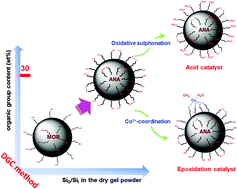One-step DGC assembly and structural characterization of a hairy particle zeolite-like organic–inorganic hybrid as an efficient modifiable catalytic material†
Abstract
Organic–inorganic hybrid microporous crystalline molecular sieves, extending the application of conventional zeolites in the fields of selective catalysis and adsorption, have aroused great interest in chemists. However, the complicated and difficult synthesis of organic–inorganic hybrid microporous molecular sieves by using a conventional hydrothermal method has hindered the rapid development of this field. The present work describes the recent progress in the synthesis of a hairy particle zeolite-like organic–inorganic hybrid with the high organic group content by one-step dry-gel conversion (DGC) assembly of organic Si, inorganic Si and other inorganic species without any organic template, which is proven to be efficient, economical, simple, and controllable. Thus-synthesized hybrid materials, as we know, with the highest organic group content reported in the literature, can be bestowed with modifiable catalytic activities by different treatments. This study will be applicable for the development of organic–inorganic hybrid catalytic materials.


 Please wait while we load your content...
Please wait while we load your content...